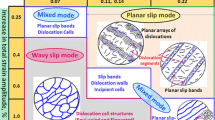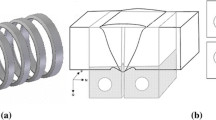Abstract
Fatigue crack growth (FCG) behavior of 316L austenitic stainless steels (SSs) is studied as a function of nitrogen concentration and load ratios, R. Addition of nitrogen to austenitic SSs, in general, improves many of its properties. Austenitic SSs are known to undergo deformation-induced martensitic transformation (DIMT), which can influence their mechanical properties. DIMT occurring near the crack tip can improve the crack growth resistance under monotonic and cyclic loads. Nitrogen, however, stabilizes the austenite inhibiting or retarding DIMT, thereby reducing the toughness. The present detailed study was undertaken to evaluate the effect of nitrogen concentration on the FCG behavior of this steel at room temperature at different load ratios. The crack growth data are analyzed using the unified approach based on the two-parametric nature of fatigue, developed by the one of the authors. Crack growth trajectory maps were constructed using the above approach. These trajectory maps show how the material resistance to crack growth changes with increasing stress intensity factor and nitrogen content. The results are compared with the crack growth trajectories derived using the published crack growth data for 304 austenitic SSs known to show DIMT. The comparison indicates that the results of the present study can be explained with transformation toughening, albeit at a reduced rate compared with nitrogen-free alloys. Fractographic and transmission electron microscopy results are also consistent with the above conclusions.
























Similar content being viewed by others
References
T. Angel, J. Iron Steel Inst. 1954, vol. 138, pp. 165–174.
F.D. Fisher, E. R. Oberaigner, K. Tanaka and F. Nishimura, Acta Metall. Mater. 1998, vol. 40, pp. 1703–1716.
F. D. Fisher, G. Reisner, E. Werner, K. Tanaka, G. Cailletaud and T. Antretter, Int. J. Plasticity, 2000, Vol. 16, pp. 723–748.
I. Tamura, Metal Science, 1982, vol. 16, pp. 245-253.
C. Müller-Bollenhagen, M. Zimmermann and H.-J.Christ, Int. J Fatigue, 2010, vol. 32 pp. 936–942.
R. J. H. Hannink, P. M. Kelly and B.C. Muddle, J. Am Ceram Soc., 2000, vol. 83, pp. 461-487.
G. B. Olson and M. Cohen, J. Less-Common Metals, 1972, vol. 28 pp.107-18
S. Chatterjee and H. K. D. H. Bhadeshia, Mater. Sci. Tech., 2017, vol. 23, pp. 1101-1104.
J.W. Hutchinson, Theoretical and Appl. Mech., 1989, pp.139-144,
A. G. Evans and R. M. Cannon, Acta Met., 1981, vol. 34, pp. 2435-2441.
H. Shaikh, T. Anita, R. K. Dayal and H. S. Khatak, Corr. Sci., 2010, vol. 52, pp. 1146–1154
M. O. Speidel, Mat-wiss. U. Werkstoiftech., 2006, vol. 37, pp. 875-880.
Z. Mei and Jr. J. W. Morris, Metall, Trans., 1990, vol. 21, pp. 3137–3152.
V. Ganesan, M. D. Mathew and K. Bhanu Sankara Rao, Mater. Sci. Technol., 2009, vol. 25, pp. 614-618.
G. Sasikala, M. D. Mathew, K. Bhanu Sankara Rao and S. L. Mannan, Metall. Trans., 2000, vol. 31, pp. 1175–85.
G. V. Prasad Reddy, R. Sandhya, K. Bhanu Sankara Rao and S. Sankaran, Procedia Eng., 2010, vol. 2, pp. 2181-2188.
M. Nani Babu, B. Shashank Dutt, S. Venugopal, G. Sasikala, Shaju K. Albert, A. K. Bhaduri and T. Jayakumar, Proc. Eng., 2013, vol. 55, pp. 716–721.
M. Nani Babu, G. Sasikala and K. Sadananda, Mater. Sci. Eng., 2018, vol. 726, pp. 18-20.
A.K. Vasudevan, K. Sadananda and N. Louat, Mater. Sci. Eng., 1994, vol. 188, pp. 1–22.
K. Sadananda, A.K. Vasudevan and R.L. Holtz, Int. J. Fatigue, 2001, vol. 23, pp. 277-286.
K. Sadananda and A. K. Vasudevan, Fatigue & Frac. Eng. Maters & Struct., 2003, vol. 26, pp. 835-845
K. Sadananda, S. Sarkar, D. Kujawski and A. K. Vasudevan, Int. J Fatigue, 2009, vol. 31, pp. 1648–1659
J. Goodman, J, ‘Mechanics Applied to Engineering’, Longmans, London, 1899.
W. Elber: in Damage Tolerance in Aircraft Design, ASTM STP 486, 1971, pp. 230–42.
N. Louat, K. Sadananda, M. Duesbery and A. K.Vasudevan, Metall. Trans., 1993, vol. 24, pp. 2225–2232.
J. Weertman, Phil. Mag., 1981, vol. 43, pp. 1103-1123
K. Sadananda and D.N. Ramaswamy, Phil. Mag., 2001, vol. 5, pp. 1283-1303.
J. Toribio and V. Kharin, Int. J Fatigue, 2013, vol. 50, pp. 72–82.
D. Kujawski and S. Stoychev, Int. J. Fatigue, 2007, vol. 29, pp. 1744-1750.
C. Laird: in Fatigue Crack Propagation, ASTM Special Technical Publication, American Society of Testing and Materials, Philadelphia, PA, 1967, p. 131.
R. J. Cooke, P. E. Irving, G. S. Booth, and C. J. Beevers, Engg. Fract. Mech., 1975, vol. 69, pp. 69–72
K. Sadananda, A. K. Vasudevan, and I. W. Kang, Acta Mater., 2003, vol. 51, pp. 3399-3414
J. B. Vogt, J. Foct, C. Regnard, G. Robert, and J. Dhers, Metall. Trans., 1991, vol. 22, pp. 2385-2392
P. Hedström and J. Odqvist: in Stainless Steel: Microstructure, Mechanical Properties and Methods of Application, Nova Science Publishers, Eds. A. Pramanik, A.K. Basak, 2015
J. Talonen, and H. Hänninen, Acta Mater., 2007, vol. 55, pp. 6108-6118
S. Kibey, J. B. Liu, M. J. Curtis, DD. Johnson, and H. Sehitoglu, Acta Mater, 2006, vol. 54, pp. 2991–3001
Acknowledgments
The authors wish to acknowledge Associate Director MEG, Director MMG and Director, IGCAR, Kalpakkam, India, for constant support and encouragement. They also acknowledge Mr. Syed Meer Kaleem for experimental assistance. We wish to acknowledge Dr. Amrita Pandian (MSG) and Dr. B. B. Lahiri (MMG) for providing TEM and MFM facilities, respectively.
Author information
Authors and Affiliations
Corresponding author
Additional information
Publisher's Note
Springer Nature remains neutral with regard to jurisdictional claims in published maps and institutional affiliations.
Manuscript submitted December 8, 2018.
Rights and permissions
About this article
Cite this article
Nani Babu, M., Sasikala, G. & Sadananda, K. Effect of Nitrogen on the Fatigue Crack Growth Behavior of 316L Austenitic Stainless Steels. Metall Mater Trans A 50, 3091–3105 (2019). https://doi.org/10.1007/s11661-019-05225-w
Received:
Published:
Issue Date:
DOI: https://doi.org/10.1007/s11661-019-05225-w




